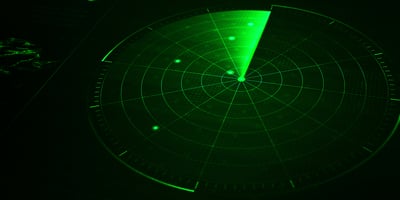In secondary surveillance radar (SSR) systems, a ground-based radar antenna transmits an...
Secondary Surveillance Radar – How Can It Be Tested More Effectively?
The roots of secondary surveillance radar (SSR) stem from identification friend or foe (IFF) technology, created during World War II. Now, it’s vital for today’s air traffic control (ATC) services.
How does SSR work? Why is SSR testing essential? What are ideal test instrument capabilities for accurate radar measurements? Discover the answers to these questions and more in the post below.
Secondary Surveillance Radar
Primary and SSR systems work hand in hand to gather important ATC information. Let’s review the basics of each:
Primary Radar: A ground-based radar antenna transmits a pulse toward the aircraft of interest and recaptures the reflected RF signals. The backscatter can reveal an aircraft’s range and bearing. While no onboard aircraft equipment is required, primary radar does not determine a target's identity, only its position.
SSR: At the heart of SSR is an aircraft’s onboard transponder, which is a device that takes in an RF signal and outputs a certain response. In SSR, the aircraft first receives an interrogation signal emitted from a ground station. The transponder decodes the interrogation to establish exactly what information is desired and sends an encoded reply. In this way SSR can determine an aircraft’s identification code and altitude.
An SSR antenna can transmit different kinds of interrogation signals to elicit a particular response from an aircraft. These interrogation signals are classified by modes.
For example, Mode A requests a target’s identification code. Mode C is similar and is used by ground stations to request an aircraft’s altitude in 100 ft increments. Mode S ups the complexity since it can request a variety of information from a target. As well as pulses, this interrogation signal includes a phase-modulated data block.
The video below shows the differences between Mode A, C, and S interrogation signals.
Read the article, "A New Approach for an Old Problem: Testing Secondary Surveillance Radar," to learn more about SSR interrogations, transponder replies, and RF power measurement challenges.
Radar Testing with the PMX40 RF Power Meter
ATC monitors, directs, and ensures the safety of its airspace, meaning SSR systems must operate seamlessly. Federal agencies require regular inspection and testing to ensure high-integrity SSR. The high level of security that aviation must maintain calls for advanced T&M capabilities and instrumentation.
The Boonton PMX40 RF Power Meter is the future of radar signal analysis. Let’s find out why.

The PMX40 offers intuitive, multi-touch operation with a large touchscreen display. Boonton USB RF power sensors easily connect to analyze the most demanding radar signals with their best-in-class performance. With this test setup, engineers can ensure their SSR system produces the required power levels at various test points.
Boonton USB RF power sensors provide 3 nanosecond rise times to track fast and narrowly spaced SSR pulses. 100 picosecond time resolution enables engineers to effectively examine pulse shapes and interpulse timing, as well as catch waveform anomalies (e.g., overshoots, dropouts, glitches, etc.).
Waveform fidelity is further validated via the sensor's Real-time Power Processing. This parallel measurement technique provides a real-time, gap-free look at radar signals with the fastest measurement rate of 100,000 per second. These measurements can also be taken over long periods of time to pinpoint any signal variations.
It doesn’t stop there. The PMX40 supports synchronous multi-channel measurements (up to four channels), and the sensors can even disconnect and be used as standalone instruments for testing.
Learn More
The PMX40 can be used throughout an SSR system’s lifecycle, from design to installation to routine maintenance. Whether it’s high performance, portability, multi-channel measurements, or long testing windows, the PMX40 with its USB RF power sensors offer an all-in-one solution for your radar testing needs.
Head over to https://boonton.com/ to learn more about how Boonton RF power measurement solutions can support current and emerging radar applications.


.png?height=200&name=AdobeStock_244017897%20(1).png)
